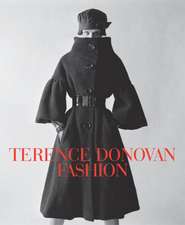The Fashion Forecasters: A Hidden History of Color and Trend Prediction
Editat de Regina Lee Blaszczyk, Ben Wubsen Limba Engleză Paperback – 7 mar 2018
| Toate formatele și edițiile | Preț | Express |
|---|---|---|
| Paperback (1) | 190.80 lei 3-5 săpt. | +55.70 lei 7-13 zile |
| Bloomsbury Publishing – 7 mar 2018 | 190.80 lei 3-5 săpt. | +55.70 lei 7-13 zile |
| Hardback (1) | 571.66 lei 3-5 săpt. | |
| Bloomsbury Publishing – 7 mar 2018 | 571.66 lei 3-5 săpt. |
Preț: 190.80 lei
Preț vechi: 218.61 lei
-13% Nou
Puncte Express: 286
Preț estimativ în valută:
36.52€ • 37.98$ • 30.56£
36.52€ • 37.98$ • 30.56£
Carte disponibilă
Livrare economică 22 februarie-08 martie
Livrare express 08-14 februarie pentru 65.69 lei
Preluare comenzi: 021 569.72.76
Specificații
ISBN-13: 9781350017177
ISBN-10: 1350017175
Pagini: 296
Ilustrații: 65 color illus
Dimensiuni: 156 x 234 x 18 mm
Greutate: 0.64 kg
Editura: Bloomsbury Publishing
Colecția Bloomsbury Visual Arts
Locul publicării:London, United Kingdom
ISBN-10: 1350017175
Pagini: 296
Ilustrații: 65 color illus
Dimensiuni: 156 x 234 x 18 mm
Greutate: 0.64 kg
Editura: Bloomsbury Publishing
Colecția Bloomsbury Visual Arts
Locul publicării:London, United Kingdom
Caracteristici
Features top interdisciplinary researchers in American and European fashion history. The lead editor, Regina Lee Blaszczyk, is a prize-winning US historian and author of The Color Revolution, which raised the bar on the historical study of forecasting in the creative industries; co-editor Ben Wubs is a rising star in European business history and the founder of a cutting-edge humanities program in fashion studies at the top-ranked Erasmus University in the Netherlands.
Notă biografică
Regina Lee Blaszczyk is Leadership Chair in the History of Business and Society and Professor of Business History at the University of Leeds in the UK. She writes about design and innovation for the creative industries. Her books include Imagining Consumers: Design and Innovation from Wedgwood to Corning (2000); Producing Fashion: Commerce, Culture, and Consumers (2008); The Color Revolution (2012); Bright Modernity: Color, Commerce, and Consumers (with Uwe Spiekermann, 2017); Fashionability: Abraham Moon and the Creation of British Cloth for the Global Market(2017); and European Fashion: The Creation of a Global Industry (with Véronique Pouillard, 2018).Ben Wubs is Professor of International Business History at the Erasmus School of History, Culture and Communication in Rotterdam and an appointed Project Professor at the Graduate School of Economics at Kyoto University in Japan. In terms of research, he is engaged in projects on multinationals, business systems, transnational economic regions, Dutch-German economic relations, and the global fashion industry. His books include International Business and National War Interests: Unilever between Reich and Empire (2008) and (with Ralf Banken) The Rhine: A Transnational Economic History (2017).
Cuprins
List of IllustrationsList of TablesAcknowledgments1. Beyond the Crystal Ball: The Rationale Behind Color and Trend ForecastingRegina Lee Blaszczyk and Ben Wubs Part I: When Paris Led and America Followed 2. The Rise of Color Forecasting in the United States and Great Britain Regina Lee Blaszczyk3. Tobé Coller Davis: A Career in Fashion Forecasting in AmericaVéronique Pouillard and Karen J. Trivette Part II: Going International 4. From Window Dresser to Fashion Forecaster: David Wolfe of the Doneger Group Tells How He Got Started in Trends 5. What Do Baby Boomers Want? How the Swinging Sixties Became the Trending SeventiesRegina Lee Blaszczyk 6. The View from Paris: Nelly Rodi and the Early Days of French Trend Forecasting 7. Fibers, Feathers, and the Future: Ornella Bignami on the Importance of Materials 8. Fashion Prediction and the Transformation of the Japanese Textile Industry: The Role of Kentaro Kawasaki, 1950-1980 Pierre-Yves Donzé9. Interstoff's Fashion Table: The Internalization of Fashion Forecasting at the World's Most Important Fashion Fabric FairBen Wubs10. The Role of the Pitti Uomo Trade Fair in the Menswear Fashion Industry Mariangela LavangaPart III: The Digital Imperative 11. Looking Behind the Scenes of Swedish Fashion ForecastingIngrid Giertz-Mårtenson 12. Trending Online: Valerie Wilson Trower Discusses Stylesight in the Asia Pacific Region13. Fast Fashion, Fast Futures: Catronia McNab on WGSN and the Global Digital WorldPart IV: Conclusion14. Fashion FuturesRegina Lee Blaszczyk and Ben WubsSelect BibliographyIndex
Recenzii
A welcome contribution to the under-researched area of fashion prediction through 'a series of cultural biographies of influential forecasters and forecasting entities' ... Includes excellent full-colour photographs and particularly fascinating reproductions of archival materials ... These books are exceptional collections of essays, timely in their arrival and inspirational in terms of the continued broadening scope of work to be done on US and global fashion.
Through carefully chosen case studies, the book provides a detailed blueprint of the development of fashion forecasting from its humble beginning in nineteenth century Paris, into a mature and complex service business in the age of big data and digital innovation. The Fashion Forecasters effectively weaves together personal narratives with archival sources, and will be of interest to academics, students, and those interested in the past, present and future of colour and trend prediction in the fashion industry.
The intuition, "sixth-sense", and impeccable taste of fashion forecasters is well worth this book's insightful analysis. How they predict who will wear what - and when - is the intriguing story of this comprehensive anthology.
For a field that is obsessed with the future, there is much to be learned from the past, as editors Blaszczyk and Wubs provide an engaging overview of the history of forecasting, giving overdue credit to the industry's originators. Meticulously researched with excellent first-person accounts, The Fashion Forecasters untangles the web of current forecasting influences and creates a clear vision for its future.
Through carefully chosen case studies, the book provides a detailed blueprint of the development of fashion forecasting from its humble beginning in nineteenth century Paris, into a mature and complex service business in the age of big data and digital innovation. The Fashion Forecasters effectively weaves together personal narratives with archival sources, and will be of interest to academics, students, and those interested in the past, present and future of colour and trend prediction in the fashion industry.
The intuition, "sixth-sense", and impeccable taste of fashion forecasters is well worth this book's insightful analysis. How they predict who will wear what - and when - is the intriguing story of this comprehensive anthology.
For a field that is obsessed with the future, there is much to be learned from the past, as editors Blaszczyk and Wubs provide an engaging overview of the history of forecasting, giving overdue credit to the industry's originators. Meticulously researched with excellent first-person accounts, The Fashion Forecasters untangles the web of current forecasting influences and creates a clear vision for its future.





















